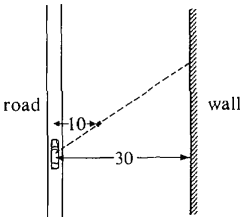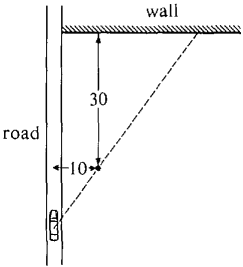| The ebook Elementary Calculus is based on material originally written by H.J. Keisler. For more information please read the copyright pages. |

|

Home  Continuous Functions Continuous Functions  Related Rates Related Rates  Problems Problems |
|






|
|
Problems
1 Each side of a square is expanding at the rate of 5 cm/sec. How fast is the area changing when the length of each side is 10 cm? 2 The area of a square is decreasing at the constant rate of 2 sq cm/sec. How fast is the length of each side decreasing when the area is 1 sq cm? 3 The vertical side of a rectangle is expanding at the rate of 1 in./sec, while the horizontal side is contracting at the rate of 1 in./sec. At time t = 1 sec the rectangle is a square whose sides are 2 in. long. How fast is the area of the rectangle changing at time t = 2 sec? 4 Each edge of a cube is expanding at the rate of 1 in./sec. How fast is the volume of the cube changing when the volume is 27 cu in.? 5 Two cars pass point P at approximately the same time, one travelling north at 50 mph, the other travelling west at 60 mph. Find the rate of change of the distance between the two cars one hour after they pass the point P. 6 A cup in the form of a right circular cone with radius r and height h is being filled with water at the rate of 5 cu in./sec. How fast is the level of the water rising when the volume of the water is equal to one half the volume of the cup? 7 A spherical balloon is being inflated at the rate of 10 cu in./sec. Find the rate of change of the area when the balloon has radius 6 in. 8 A snowball melts at the rate equal to twice its surface area, with area in square inches and melting measured in cubic inches per hour. How fast is the radius shrinking? 9 A ball is dropped from a height of 100 ft, at which time its shadow is 500 ft from the ball. How fast is the shadow moving when the ball hits the ground? The ball falls with velocity 32 ft/sec, and the shadow is cast by the sun. 10 A 6 foot man walks away from a 10 foot high lamp at the rate of 3 ft/sec. How fast is the tip of his shadow moving? 11 A car is moving along a road at 60 mph. To the right of the road is a bush 10 ft away and a parallel wall 30 ft away. Find the rate of motion of the shadow of the bush on the wall cast by the car headlights.
12 A car moves along a road at 60 mph. There is a bush 10 ft to the right of the road, and a wall 30 ft behind the bush is perpendicular to the road. Find the rate of motion of the shadow of the bush on the wall when the car is 26 ft from the bush.
13 An airplane passes directly above a train at an altitude of 6 miles. If the airplane moves north at 500 mph and the train moves north at 100 mph, find the rate at which the distance between them is increasing two hours after the airplane passes over the train. 14 A rectangle has constant area, but its length is growing at the rate of 10 ft/sec. Find the rate at which the width is decreasing when the rectangle is 3 ft long and 1 ft wide. 15 A cylinder has constant volume, but its radius is growing at the rate of 1 ft/sec. Find the rate of change of its height when the radius and height are both 1 ft. 16 A country has constant national income, but its population is growing at the rate of one million people per year. Find the rate of change of the per capita income (national income divided by population) when the population is 20 million and the national income is 20 billion dollars. 17 If at time t a country has a birth rate of 1,000,000t births per year and a death rate of 300,000√t deaths per year, how fast is the population growing? 18 The population of a country is 10 million and is increasing at the rate of 500,000 people per year. The national income is $10 billion and is increasing at the rate of $100 million per year. Find the rate of change of the per capita income. 19 Work Problem 18 assuming that the population is decreasing by 500,000 per year. 20 Sand is poured at the rate of 4 cu in./sec and forms a conical pile whose height is equal to the radius of its base. Find the rate of increase of the height when the pile is 12 in. high. 21 A circular clock has radius 5 in. At time t minutes past noon, how fast is the area of the sector of the circle between the hour and minute hand increasing? (t ≤ 60). 22 The demand x for a commodity at price p is x = 1/(1 + √p). Find the marginal revenue, that is, the change in revenue per unit change in x, when the price is $100 per unit. 23 x units of a commodity can be produced at a total cost of y = 100 + 5x. The average cost is defined as the total cost divided by x. Find the change in average cost per unit change in x (the marginal average cost) when x = 100. 24 The demand for a commodity at price p is x = 1/(p + p3). Find the change of the price per unit change in x, dp/dx, when the price is 3 dollars per unit. 25 In one day a company can produce x items at a total cost of 200 + 3x dollars and can sell x items at a price of 5 - x/1000 dollars per item. Profit is defined as revenue minus cost. Find the change in profit per unit change in the number of items x (marginal profit). 26 In one day a company can produce x items at a total cost of 200 + 3x dollars and can sell x = 1000/√y items at a price of y dollars per item. (a) Find the change in profit per dollar change in the price y (the marginal profit with respect to price). (b) Find the change in profit per unit change in x (the marginal profit). 27 An airplane P flies at 400 mph one mile above a line L on the surface. An observer is at the point O on L. Find the rate of change (in radians per hour) of the angle θ between the line L and the line OP from the observer to the airplane when θ = π/6. 28 A train 20 ft wide is approaching an observer standing in the middle of the track at 100 ft/sec. Find the rate of increase of the angle subtended by the train (in radians per second) when the train is 20 ft from the observer. 29 Find the rate of increase of e2x+3y when x = 0, y = 0, dx/dt = 5, and dy/dt = 4. 30 Find the rate of change of ln A where A is the area of a rectangle of sides x and y when x = 1, y = 2, dx/dt = 3, dy/dt = -2.
|
|
Home  Continuous Functions Continuous Functions  Related Rates Related Rates  Problems Problems |
|
Last Update: 2006-11-25



